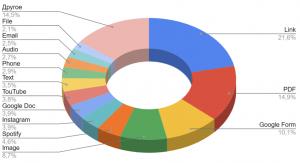QR Codes Take Over the U.S.: Top Types & Trends in 2025 — ME-QR Stats
Insights from 2M+ QR codes reveal the fastest-growing use cases and industries in the U.S.
LONDON, UNITED KINGDOM, September 24, 2025 /EINPresswire.com/ -- Once used solely for quick link access, QR codes in the United States have now become a universal tool embedded into everyday digital infrastructure — from marketing campaigns and education to restaurant menus and product packaging.
ME-QR, one of the leading QR code generation platforms, analyzed over 2 million codes created in the U.S. in just the first six months of 2025 — and now we know exactly which types of QR codes are the most popular and which industries are experiencing the biggest boom.
Whether you work in digital, marketing, or simply want to understand where the U.S. tech market is heading — this report is for you. Dive in — the most interesting part starts below.
Which QR Codes Are Created Most Often in the U.S.: A Breakdown by Type
QR codes have long evolved beyond being just a tool for scanning links — today, they are an essential part of American marketing, education, logistics, and many other industries. The ME-QR platform has collected data on QR code creation in 2025, and we’ve prepared an analytical overview of the most commonly generated types in the U.S.
QR Code Type | Share (%)
Link | 21,58%
PDF | 14,94%
Google Form | 10,15%
Image | 8,70%
Spotify | 4,60%
Instagram | 3,95%
Google Doc | 3,87%
YouTube | 3,84%
Text | 3,54%
Phone | 2,95%
Audio | 2,72%
Email | 2,48%
File | 2,14%
Other | 14,55%
Insights:
1. The U.S. leads in using QR codes for digital documents and forms. Combined, PDFs (14.94%), Google Forms (10.15%), Google Docs (3.87%), and files (2.14%) account for over 30% of all QR codes. This indicates that American users actively leverage QR codes to streamline processes in education, HR, internal workflows, and events.
2. Simple links are losing ground. Although URLs remain the most popular type (21.58%), their share in the U.S. is notably lower than the global average (nearly 29%). This suggests a shift toward more specialized uses of QR codes.
3. A high share of the “Other” category signals diversity. Nearly 15% of QR codes fall under "Other," which may include bookings, payments, Wi-Fi access, messaging apps, and custom designs. This points to broad experimentation and a drive to explore new ways of engaging audiences.
The Future of QR Code Types in the U.S.
The way Americans use QR codes is steadily evolving, moving beyond simple redirects and becoming a versatile tool across industries. Several long-term trends already stand out:
- Document-focused usage is on the rise. PDFs, Google Forms, Docs, and file-sharing together account for more than 30% of all QR codes in the U.S. This highlights how schools, businesses, and event organizers are adopting QR codes as a seamless way to share documents, collect data, and manage internal processes.
- Link QR codes are losing their monopoly. While they remain the single most popular format, their share is noticeably smaller compared to global averages. This shows that American users increasingly prefer specialized QR types tailored to specific needs.
- Media and entertainment are gaining momentum. With growing shares of images, Spotify, YouTube, and audio formats, QR codes are becoming a gateway to music, video, and creative content — fueling engagement in entertainment and marketing campaigns.
- Social and communication functions remain strong. Instagram, phone, text, and email QR codes continue to play a key role in personal branding, customer service, and direct interactions between businesses and audiences.
- Experimentation is shaping the future. Nearly 15% of QR codes fall into the “Other” category, which covers payments, Wi-Fi access, custom designs, and emerging use cases. This diversity signals that QR codes in the U.S. will keep expanding into new industries and consumer experiences.
In the long run, QR codes in the U.S. will be defined by diversification. From education and HR to media and retail, they are transforming into flexible digital tools that adapt to the needs of both businesses and consumers, opening the door to constant innovation and new engagement formats.
Ivan Melnychuk
ME-QR
support@me-qr.com
Visit us on social media:
LinkedIn
Instagram
Facebook
YouTube
Legal Disclaimer:
EIN Presswire provides this news content "as is" without warranty of any kind. We do not accept any responsibility or liability for the accuracy, content, images, videos, licenses, completeness, legality, or reliability of the information contained in this article. If you have any complaints or copyright issues related to this article, kindly contact the author above.

